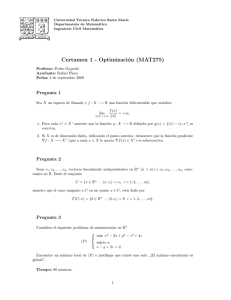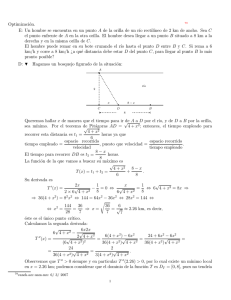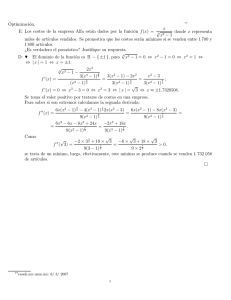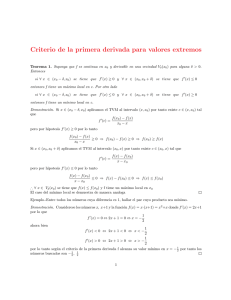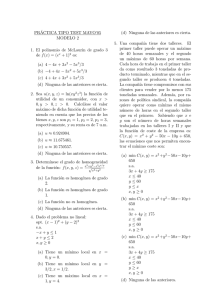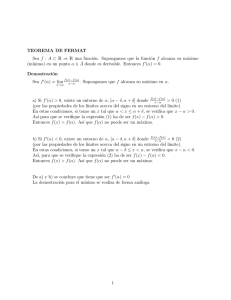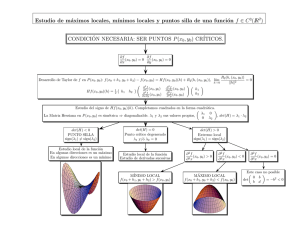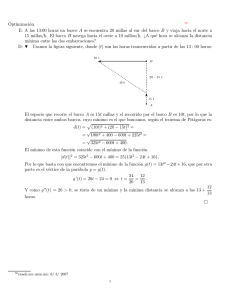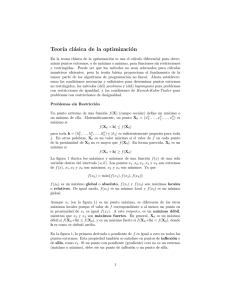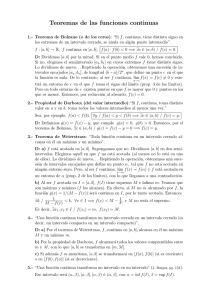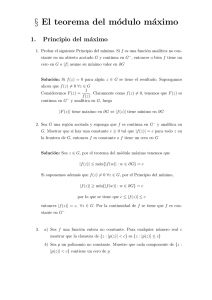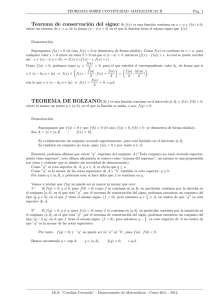en n subintervalos iguales, cada uno de lo
Anuncio
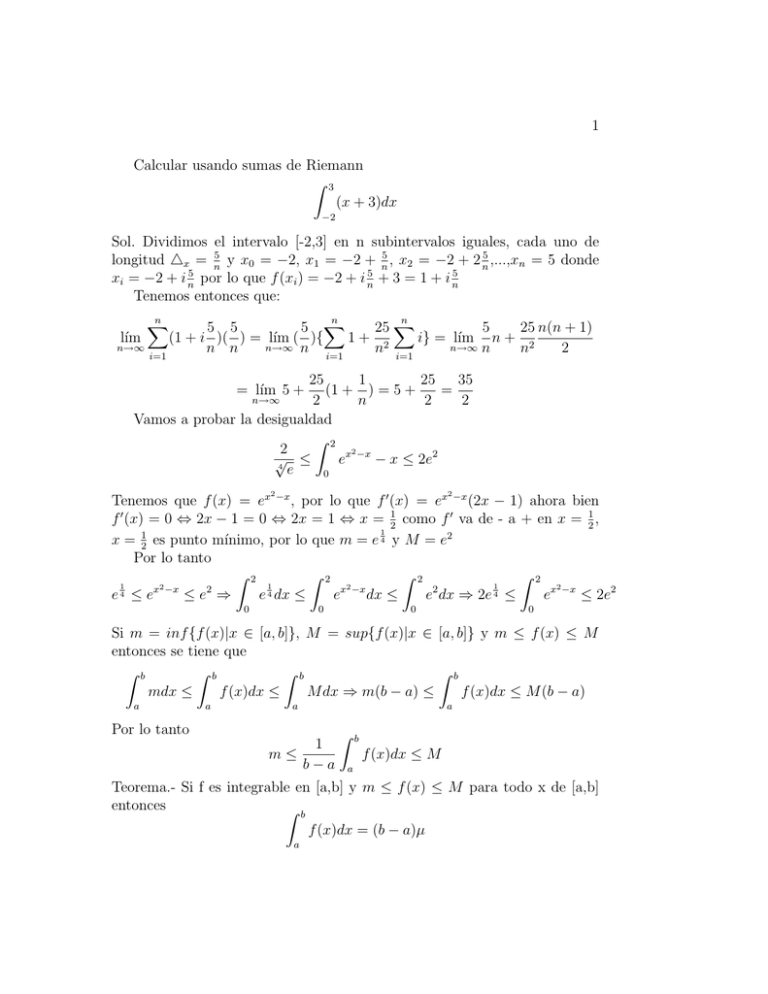
1
Calcular usando sumas de Riemann
Z 3
(x + 3)dx
−2
Sol. Dividimos el intervalo [-2,3] en n subintervalos iguales, cada uno de
longitud 4x = n5 y x0 = −2, x1 = −2 + n5 , x2 = −2 + 2 n5 ,...,xn = 5 donde
xi = −2 + i n5 por lo que f (xi ) = −2 + i n5 + 3 = 1 + i n5
Tenemos entonces que:
n
n
n
X
5 5
5 X
25 X
5
25 n(n + 1)
lı́m
(1 + i )( ) = lı́m ( ){
1+ 2
i} = lı́m n + 2
n→∞
n→∞ n
n→∞ n
n n
n i=1
n
2
i=1
i=1
1
25
35
25
(1 + ) = 5 +
=
n→∞
2
n
2
2
Vamos a probar la desigualdad
Z 2
2
2
√
≤
ex −x − x ≤ 2e2
4
e
0
= lı́m 5 +
2
2
Tenemos que f (x) = ex −x , por lo que f 0 (x) = ex −x (2x − 1) ahora bien
f 0 (x) = 0 ⇔ 2x − 1 = 0 ⇔ 2x = 1 ⇔ x = 21 como f 0 va de - a + en x = 12 ,
1
x = 12 es punto mı́nimo, por lo que m = e 4 y M = e2
Por lo tanto
Z 2
Z 2
Z 2
Z 2
1
1
1
2
x2 −x
2
x2 −x
2
4
4
4
e ≤e
≤e ⇒
e dx ≤
e
dx ≤
e dx ⇒ 2e ≤
ex −x ≤ 2e2
0
0
0
0
Si m = inf {f (x)|x ∈ [a, b]}, M = sup{f (x)|x ∈ [a, b]} y m ≤ f (x) ≤ M
entonces se tiene que
Z b
Z b
Z b
Z b
mdx ≤
f (x)dx ≤
M dx ⇒ m(b − a) ≤
f (x)dx ≤ M (b − a)
a
a
a
a
Por lo tanto
1
m≤
b−a
Z
b
f (x)dx ≤ M
a
Teorema.- Si f es integrable en [a,b] y m ≤ f (x) ≤ M para todo x de [a,b]
entonces
Z b
f (x)dx = (b − a)µ
a
2
para un cierto µ con m ≤ µ ≤ M
Tenemos por lo demostrado anteriormente que
Z b
Z b
Z b
1
1
m≤
f (x)dx ≤ M ⇒ µ =
f (x)dx ⇒ µ(b−a) =
f (x)dx
b−a a
b−a a
a
Teorema.- Si f es continua en [a,b] entonces
Z
f (ξ)(b − a) =
b
f (x)dx
a
para un cierto ξ ∈ [a, b]
Dem Si m y M son los valores máximo y mı́nimo de f sobre [a,b] al ser f
continua alcanza todos los valores y por lo tanto f (ξ) = µ por lo tanto
1
f (ξ) =
b−a
Z
b
Z
f (x)dx ⇒ f (ξ)(b − a) =
a
b
f (x)dx
a
R5 2
50
Vamos a probar que 2 < 1 x2x+1 dx < 13
R5
2
Si f (x) = x2x+1 Tenemos entonces que 1
con 1 ≤ α ≤ 5.
Ahora bien
x2
dx
x2 +1
1 ≤ α ⇒ 12 ≤ α2 ⇒ 12 + 1 ≤ α2 + 1 ⇒
α ≤ 5 ⇒ α2 ≤ 52 ⇒ α2 + 1 ≤ 52 + 1 ⇒
=
α2
(5
α2 +1
− 1)
α2
1
1
≤ 2
+1
1 +1
52
1
1
≤ 2
+1
α +1
Por lo tanto
1
1
1
1
α2
25
<
1
−
<
1
−
⇒
<
<
2
2
2
2
1 +1
α +1
5 +1
2
α +1
26
Z 5
1
α2
25
x2
50
⇒ (5 − 1) < 2
(5 − 1) < (5 − 1) ⇒ 2 <
dx <
2
2
α +1
26
13
1 x +1
1−
Teorema.- Supóngase que f es una función continua en [a,b] y que g es
una función integrable y no negativa en [a,b]. Demostrar que
Z
b
Z
f (x)g(x)dx = f (ξ)
a
b
g(x)dx
a
3
con ξ ∈ [a, b]
Dem Tenemos que si m M son respectivamente los valores máximo y
mı́nimo de f sobre [a,b], se tiene que
Z
b
Z
a
en consecuencia
Rb
f (x)g(x)dx
≤M
Rb
g(x)
a
a
m≤
Por lo tanto existe ξ ∈ [a, b] tal que
Rb
a
f (ξ) =
Por lo tanto
Z
f (ξ)
f (x)g(x)dx
Rb
g(x)
a
b
Z
g(x) =
a
b
f (x)g(x)dx
a
Utilizar lo anterior para mostrar que
Z 1
1
x6
1
√ ≤
√
dx ≤
2
7
1+x
7 2
0
1
6
elegimos f (x) = √1+x
2 y g(x) = x
Por lo tanto
Z 1
Z 1
1
x6
1
√
dx = p
x6 dx = p
1 + x2
1 + ξ2 0
7 1 + ξ2
0
como 0 ≤ ξ ≤ 1 entonces
1
1
1
√
≤ √
≤ p
2
7 1+1
7 1 + 02
7 1 + ξ2
Por lo tanto
1
√ ≤
7 2
Z
0
1
√
x6
1
dx ≤
7
1 + x2
Z
f (x)g(x)dx ≤ M
g(x)dx ≤
m ≤ f (x) ≤ M ⇒ mg(x) ≤ f (x)g(x) ≤ M g(x) ⇒ m
b
a
b
g(x)
a
